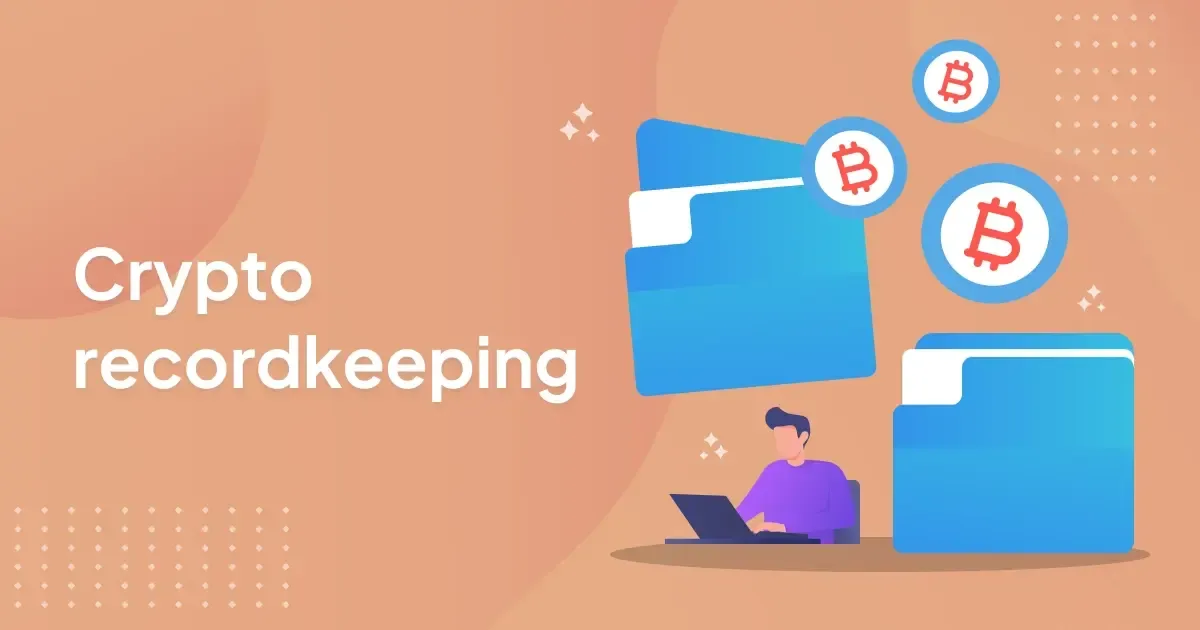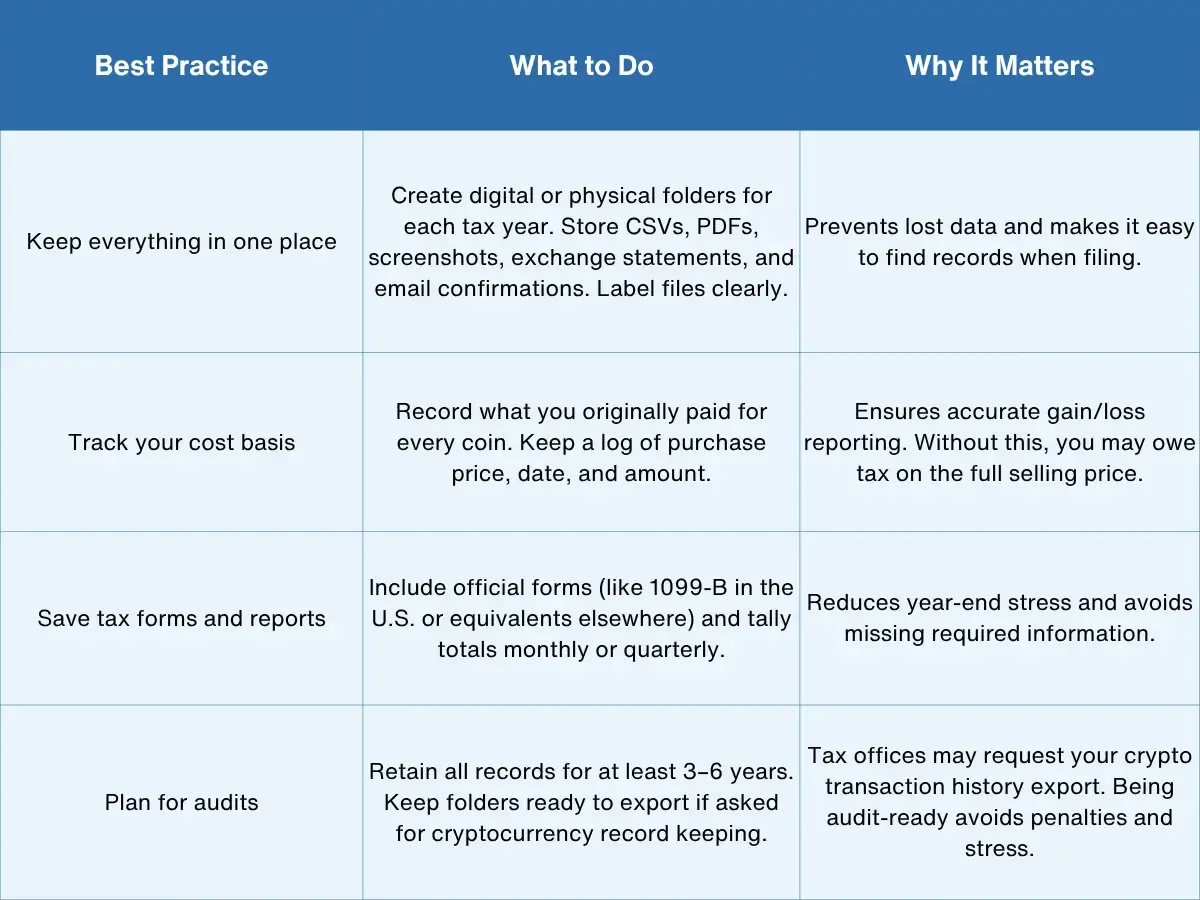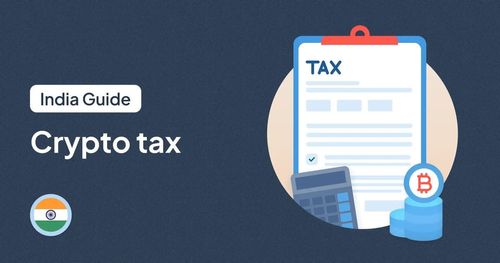
Good crypto recordkeeping is like collecting receipts for your crypto.
Even though crypto moves on the blockchain, tax agencies and auditors will expect you to document everything: what you buy, sell, or trade. Save the date, coin, and amount for every transaction, so you can easily answer questions later.
A simple habit is to track transactions as they happen. Treat your crypto records like your bank receipts. The rules are clear: you need to keep track of your crypto activity and report it when tax time comes.
It might sound a little daunting to keep track of your crypto activities. But don’t worry. We’re here to help. Read on to explore crypto best practices for managing wallets, exchanges, and DeFi.
Table of contents |
No credit card required
Quick Crypto Record Keeping Checklist
Here is the list you should check first.
|
Building good recordkeeping habits is key. You don’t need to be an accountant to do it. You just need a simple system and, ideally, the right tools to help you along. So, how to organize crypto transaction history? How to stay safe? Let’s go through the major best practices below, one by one.
1. Organize Your Wallets Clearly
The first step to clear records is knowing which wallet is which. Good organization and naming make all the difference, especially for multi-wallet crypto recordkeeping.
●Give wallets nicknames. Think of them like folders on your computer. Whether you’re using an app that lets you rename them or you keep a small list yourself, call one “Daily Spending,” another “Savings,” and so on.
● Keep a simple record of addresses. Even a basic spreadsheet or notebook works. Just list the wallet name, its address, and what you use it for.
● Use a tracking tool if you prefer all-in-one. Platforms like cryptact let you connect wallets and label them inside one dashboard, so you don’t have to manage notes and spreadsheets separately.
Use your wallet app’s features.
Many wallets or portfolio apps let you tag or color-code addresses. Take advantage of these tools so you don’t confuse different accounts.
Note transfers between your own wallets.
If you move coins from one of your wallets to another, record it as an internal transfer, not a new purchase. For example, if you shift coins from your hardware wallet to an exchange, log the date and amounts so you remember it wasn’t a sale.
Instead of keeping random notes, you can use a tool like cryptact to automatically track and categorize these transfers, so all your records stay in one place without extra manual effort.
Doing this helps ensure you don’t count the same coins twice in your multi-wallet crypto recordkeeping.
2. Back Up Your Keys and Phrases
Recordkeeping only matters if you can actually access your funds, so protect your keys first. Let’s look at some crypto key backup best practices.
Think of a hardware wallet as an offline vault for your crypto. It keeps your private keys safe from online hackers.
If you use a hardware wallet, always write down the recovery (seed) phrase it gives you. It’s part of the first crypto key backup best practices anyone will tell you. If you use a software wallet instead, write down your private key or seed phrase on paper or a sturdy metal backup.
Never take a photo or store your seed phrase in a cloud app or notes on your phone. Only keep these words offline. Store that backup in a safe place (or even two places) so you can recover your funds if something happens to the device. Treat the backup phrase like money itself: protect it from theft, loss, and damage. It’s critical to follow crypto security best practices.
3. Save Your Trade History with Centralized Exchanges
Exchanges keep records for you, but you should never depend on them to store your entire history.
Download your history often
Most exchanges let you export your trade history as a CSV or PDF. Do this at least once a year (or more often if you trade frequently). Save the files on your computer or in cloud storage (you might even zip and email them to yourself) as part of your crypto recordkeeping.
Many crypto tax pros say: “Exchanges can go down…your data shouldn’t.”. Keeping a local copy of each yearly statement or report, you won’t lose all your history if an exchange suddenly closes or changes its website.
Keep transaction receipts
If you buy crypto with a credit card, bank transfer, or other payment, save those receipts or confirmation emails. Maintain a crypto transaction history export.
This shows the fiat amount you paid. Recording what you originally paid (the cost basis) for each coin is important. If you have proof of purchase, you won’t have to assume you paid nothing when calculating gains later.
Save any tax forms or reports from the exchange
Some exchanges send annual tax documents (like a Form 1099 in the U.S.) for large users. If you get one, keep it in your files. Also keep screenshots or PDF records of any coin conversions or staking rewards reports. Even notes about wallet addresses or small trades can help you reconcile things later, establishing a good multi-wallet crypto recordkeeping workflow.
4. Track Details from Decentralized Finance (DeFi) Platforms
DeFi transactions don’t come with convenient statements, so you need to do the crypto recordkeeping yourself:
Record each action on a DeFi app
Whether you trade on a decentralized exchange, lend coins in a pool, or stake tokens, note the details. Write down the date, coin amounts, and what happened. For example, if you swapped ETH for an altcoin on a platform, your cryptocurrency record keeping should include how much of each and when.
Use block explorers if needed
You can look up any wallet’s transactions on various sites, or via different tools. Copy the transaction hashes or take screenshots as proof of what happened. This is useful when, say, you bridge coins between networks or unstake rewards. You’ll have a record of the token amounts and time.
Include DeFi income
If you earn interest, yield farming rewards, or receive airdrops on DeFi, log them as income on the date received. As crypto best practices, keep notes of what you did to earn them. For example, if a protocol paid you in tokens for staking, track those tokens’ value on the date you got them.
Organize Records for Taxes and Audits
Here is 4 best practices you should follow.

The Ultimate Suggestion: Use a Tool to Track Everything
Many people find it helpful to keep a simple tracker. You can indulge in crypto asset tracking without tax software. Build a Google Sheet or Excel file to list every buy, sell, or transfer. Each line might include the date, coin, amount, price, fees, and wallet name. You can even use crypto APIs to fill in prices automatically.
However, there are smarter, more accurate, and far more efficient alternatives available today. Portfolio and crypto tax tools like cryptact that can import transactions from exchanges and wallets.
These tools will give you a complete list of your activity and can generate reports. However, always double-check totals and entries yourself at least once. When picking a tool, make sure to conduct a crypto recordkeeping tools comparison to find the best fit for yourself.
Conclusion
Good recordkeeping helps you sleep better. You’ll know you’ve protected your crypto and can handle tax questions if they come up! Keeping crypto records may feel like extra work, but it’s the foundation of safe, stress-free investing.
The easiest way to stay on top of it all is by using a tool like cryptact. It connects your wallets, exchanges, and DeFi accounts. It helps you carry out reliable cryptocurrency record keeping for every transaction. It has many more features, which you should certainly explore so that you ultimately free up time for what matters the most: growing your portfolio.
Take the hassle out of recordkeeping. Try cryptact today and manage your crypto with confidence.



